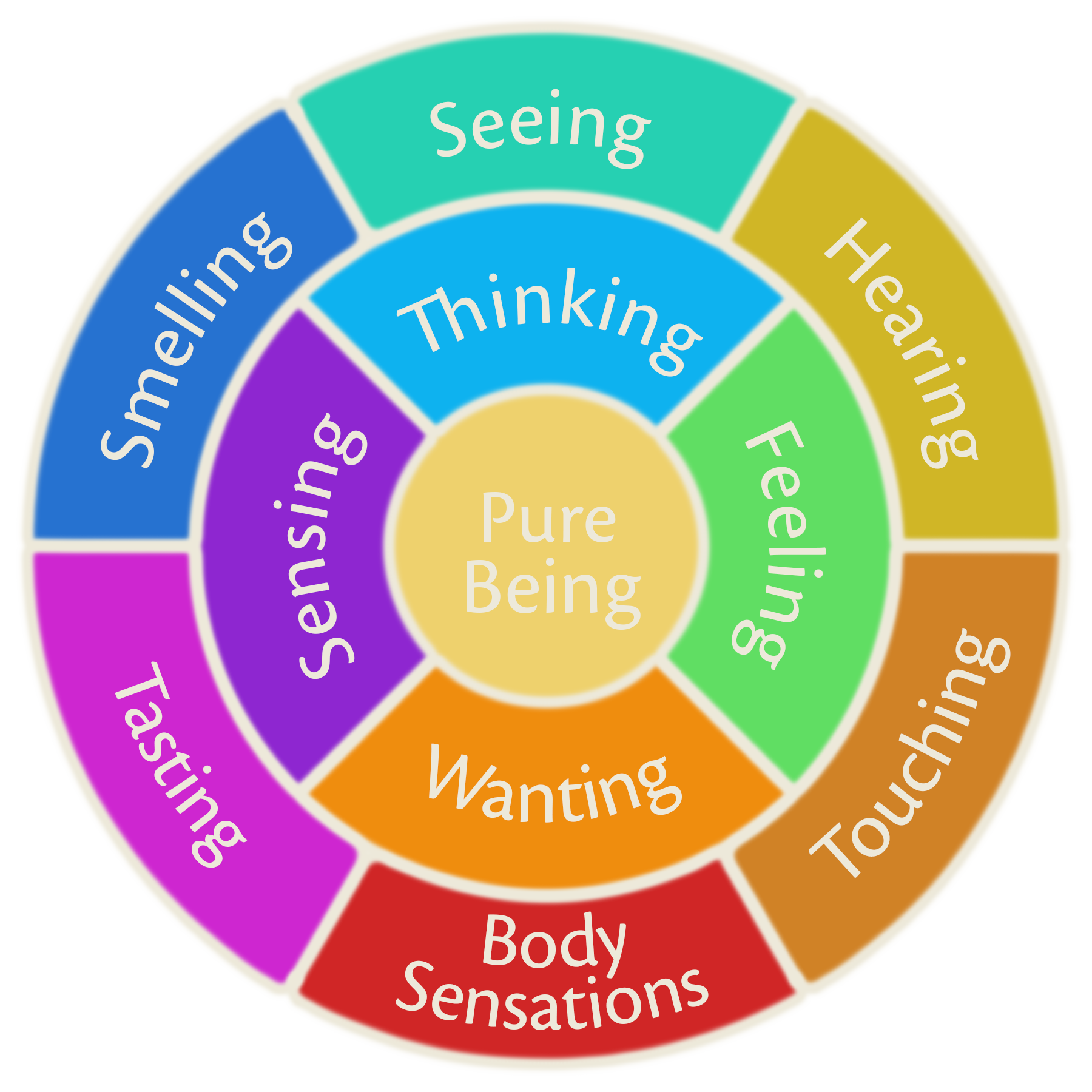
Theory
of Human Experience

The first general description of human experience
Published by Christoph Steinbach on July 6, 2014 in Überlingen, Germany
↑ The theory as an image ↓ in words
«I see, hear, smell, taste, touch, have bodily sensations, sense, feel, think, want and I AM in every moment.»
These are the eleven areas of human experience (see illustration). Every single human perception can be found in one of these eleven areas.
The experience of a moment is an indivisible mystery. This theory helps us to better describe our experiences and to become more aware of ourself.
‹Experience›, in this context, is not a special event, but rather a constant occurrence in the lives of us conscious people on earth.
There is not a single moment, in which we are not experiencing something – all eleven areas are filled with experience at every moment. Part of our experience is mostly unconscious to us.
‹Perception› and ‹Experience› are used synonymously on this page.
→ Read and see a detailed description of the eleven areas here

Further statements on the theory of experience:
«I do, be effective and experience at the same time. Life is more than experiencing.»
Our life is doing and being – pure experience is being. Experiencing is the passive part of our life. Doing is more than just experiencing. As a human being on earth it is not possible just to be – there is always an action present, even if only in spirit.
«I am consciousness, that is constantly narrowing and expanding, and attention, that is moving through space.»
In conscious moments, you can experience the momentary expanse of your own consciousness: Sometimes I am «in the space of thoughts» and apart from seeing and hearing, I hardly notice the other areas … sometimes «I'm wide inside» and perceive many of the eleven areas of experience at the same time.
In conscious moments, you can experience the current location of your own attention: Sometimes the attention rests within me and sometimes it is outside, for example with a person or event in front of me. Now I have «stepped out of myself».

Maybe you are now asking yourself this question:
What benefit do I have from a complete description of my experience?
 By searching and finding the areas in your own experience, you become more self-aware.
By searching and finding the areas in your own experience, you become more self-aware.
 You learn to differentiate between feelings and body sensations.
You learn to differentiate between feelings and body sensations.
 By consciously feeling your body, you recognize the independence of your feeling from the simultaneous body sensations. This will free you from some sufferings.
By consciously feeling your body, you recognize the independence of your feeling from the simultaneous body sensations. This will free you from some sufferings.
 By consciously seeing, hearing, smelling, tasting, touching, thinking, feeling and being aware of your body sensations, you can discover the miracle of sensing. (The impressions of sensing are not included in the first-mentioned areas.)
By consciously seeing, hearing, smelling, tasting, touching, thinking, feeling and being aware of your body sensations, you can discover the miracle of sensing. (The impressions of sensing are not included in the first-mentioned areas.)
 When you interact with sensitive people, you can see that the impressions of sensing are sensory impressions. Through this, they are largely objective.
When you interact with sensitive people, you can see that the impressions of sensing are sensory impressions. Through this, they are largely objective.
 By observing which areas you are consciously experiencing in this moment, you can determine the breadth of your current awareness.
By observing which areas you are consciously experiencing in this moment, you can determine the breadth of your current awareness.
 By consciously switching your attention from one area to the next, you become aware of the nature of your attention.
By consciously switching your attention from one area to the next, you become aware of the nature of your attention.
 If you also mention the areas of experience when describing an experience, you can communicate your experience better and more clearly.
If you also mention the areas of experience when describing an experience, you can communicate your experience better and more clearly.
 By consciously distinguishing between the eleven areas of experience in speaking, we will clarify our language for inner events. (Some words still have multiple usages in our everyday language, such as ‹to feel›.)
By consciously distinguishing between the eleven areas of experience in speaking, we will clarify our language for inner events. (Some words still have multiple usages in our everyday language, such as ‹to feel›.)
 You can consciously devote yourself to one of the areas (for example seeing) and thereby achieve the silence of thinking.
You can consciously devote yourself to one of the areas (for example seeing) and thereby achieve the silence of thinking.
 By dedicating yourself completely to your feelings for a while, you can recognize the independence of your feelings from your thoughts.
By dedicating yourself completely to your feelings for a while, you can recognize the independence of your feelings from your thoughts.
 In the silence of thought you recognize the pure feelings and their possible mixtures. (Pure feelings have no mental component. In the silence of thought your feeling is not necessarily love and joy.)
In the silence of thought you recognize the pure feelings and their possible mixtures. (Pure feelings have no mental component. In the silence of thought your feeling is not necessarily love and joy.)
 By feeling consciously, we gradually recognize the meaning of the six basic feelings.
By feeling consciously, we gradually recognize the meaning of the six basic feelings.
 By thinking consciously, we recognize the gifts and also shadows of thinking.
By thinking consciously, we recognize the gifts and also shadows of thinking.
 The more consciously we experience the eleven areas, the more our feeling and thinking will connect in love and we will speak and act more wisely from within ourselves.
The more consciously we experience the eleven areas, the more our feeling and thinking will connect in love and we will speak and act more wisely from within ourselves.
 The dominance of thinking and the associated suppression of feeling will end and we will flourish.
The dominance of thinking and the associated suppression of feeling will end and we will flourish.
 This general description connects us as humans because it shows us that we all have the same areas of experience – only the content in the areas varies from person to person and from moment to moment.
This general description connects us as humans because it shows us that we all have the same areas of experience – only the content in the areas varies from person to person and from moment to moment.
 By gradually consciously experiencing your own senses, your own body sensations, feeling, thinking and wanting, it is possible to experience the PURE BEING within yourself and thus to a certain extent YOURSELF.
By gradually consciously experiencing your own senses, your own body sensations, feeling, thinking and wanting, it is possible to experience the PURE BEING within yourself and thus to a certain extent YOURSELF.
 The more we are OURSELVES, the wiser, more loving and more powerful we are. We will rebuild life on earth in harmony with nature and Mother Earth.
The more we are OURSELVES, the wiser, more loving and more powerful we are. We will rebuild life on earth in harmony with nature and Mother Earth.

For the intrepid among us:
«All humans on earth live on three levels at the same time: in the bodily-physical level (third spatial dimension), in the soul-spiritual level (fourth spatial dimension) and in the all-pervasive space of the ONE LIFE.»
We are incarnated in the first two levels and are therefore integrated into a structure of time, space, cause and effect.
These three levels are also shown in the illustration: It is the soul spirit (inner five areas) that thinks, speaks in words, feels, wants and senses. The body is a shell, a vehicle, a physical expression of the soul spirit that inhabits it. Once the soul spirit leaves the body forever, the body is lifeless.
The soul spirit has senses: Even when it is detached from the body, it sees, hears, touches and senses.
Our soul spirit is also incarnated and therefore has an individual presence. When our soul spirit dissolves, we are LIFE ITSELF, unseparated from all life and all beings.

This insight is one of the keys to the New Era – an era of awareness, spatial dimensions and closeness.

Imprint
The description of the human experience is part of the jahnna project, which has been publishing exercises, consciousness and visions of humanity since 2003. All content is a free gift for all loving and open-hearted people.
More about the jahnna project at: www.jahnna.ch (in german language)
More about the Psychology of Experience: www.erlebbare-psychologie.ch (in german too)
A visit to the author of this page: www.luetzelhuus.ch -› Über uns
This page published on February 22th, 2024





